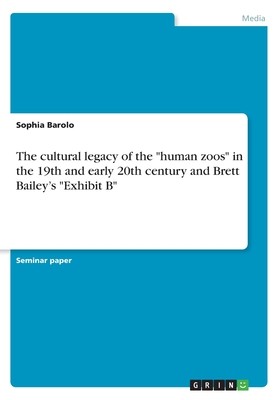
- We will send in 10–14 business days.
- Author: Sophia Barolo
- Publisher: GRIN Verlag
- Year: 2017
- Pages: 20
- ISBN-10: 3668498253
- ISBN-13: 9783668498259
- Format: 17.8 x 25.4 x 0.1 cm, minkšti viršeliai
- Language: English
- SAVE -10% with code: EXTRA
The cultural legacy of the human zoos in the 19th and early 20th century and Brett Bailey's Exhibit B (e-book) (used book) | bookbook.eu
Reviews
Description
Seminar paper from the year 2017 in the subject Art - History of Art, grade: 2,3, University of Lisbon, language: English, abstract: This paper analyzes the beginnings of the so-called "human zoos" in the late 19th and early 20th century and whether there are still continuities of these practices in the present world. What are the consequences, what are the impacts? It will further look into the example of Sarah Baartman, who was objectified and exhibited 1810 to 1815, in order to illustrate the horrible fates of people on display in Europe. Are human beings still exhibited and exploited in the way they used to be? The South African Artist Brett Bailey made an attempt to spread awareness of the highly popular human zoos with his show Exhibit B. The show was received very controversial by the public and in London the show even had to be cancelled due to the dimensions of the protests. The question is whether by re-creating scenes of slavery his show is able to provide a critique of racism and human-zoos or whether it is a mere reproduction of human zoos that is racist in itself. It is in the nature of human kind to be curious and to observe things that are new to the eye. Only by observation can be recognized whether something is a danger or not. The unusual thus always exerts a strong appeal to the observer. The "exotic" has always attracted attention. This even more when an unfamiliar looking or "exotic" human being is concerned, a being that seems very familiar to the viewer and possibly even shows him similarities to himself. This is one of the reasons why "wild people" have been displayed at fun fairs and exhibitions during centuries, and since traveling was dangerous or not possible at all and a worldwide media network did not exist, these exhibitions were often the only opportunity to see people from far away in real life. It is hardly surprising that this natural interest in the stranger has quickly been utilized by some people for their own benefit, wheth
EXTRA 10 % discount with code: EXTRA
The promotion ends in 23d.11:08:12
The discount code is valid when purchasing from 10 €. Discounts do not stack.
- Author: Sophia Barolo
- Publisher: GRIN Verlag
- Year: 2017
- Pages: 20
- ISBN-10: 3668498253
- ISBN-13: 9783668498259
- Format: 17.8 x 25.4 x 0.1 cm, minkšti viršeliai
- Language: English English
Seminar paper from the year 2017 in the subject Art - History of Art, grade: 2,3, University of Lisbon, language: English, abstract: This paper analyzes the beginnings of the so-called "human zoos" in the late 19th and early 20th century and whether there are still continuities of these practices in the present world. What are the consequences, what are the impacts? It will further look into the example of Sarah Baartman, who was objectified and exhibited 1810 to 1815, in order to illustrate the horrible fates of people on display in Europe. Are human beings still exhibited and exploited in the way they used to be? The South African Artist Brett Bailey made an attempt to spread awareness of the highly popular human zoos with his show Exhibit B. The show was received very controversial by the public and in London the show even had to be cancelled due to the dimensions of the protests. The question is whether by re-creating scenes of slavery his show is able to provide a critique of racism and human-zoos or whether it is a mere reproduction of human zoos that is racist in itself. It is in the nature of human kind to be curious and to observe things that are new to the eye. Only by observation can be recognized whether something is a danger or not. The unusual thus always exerts a strong appeal to the observer. The "exotic" has always attracted attention. This even more when an unfamiliar looking or "exotic" human being is concerned, a being that seems very familiar to the viewer and possibly even shows him similarities to himself. This is one of the reasons why "wild people" have been displayed at fun fairs and exhibitions during centuries, and since traveling was dangerous or not possible at all and a worldwide media network did not exist, these exhibitions were often the only opportunity to see people from far away in real life. It is hardly surprising that this natural interest in the stranger has quickly been utilized by some people for their own benefit, wheth


Reviews